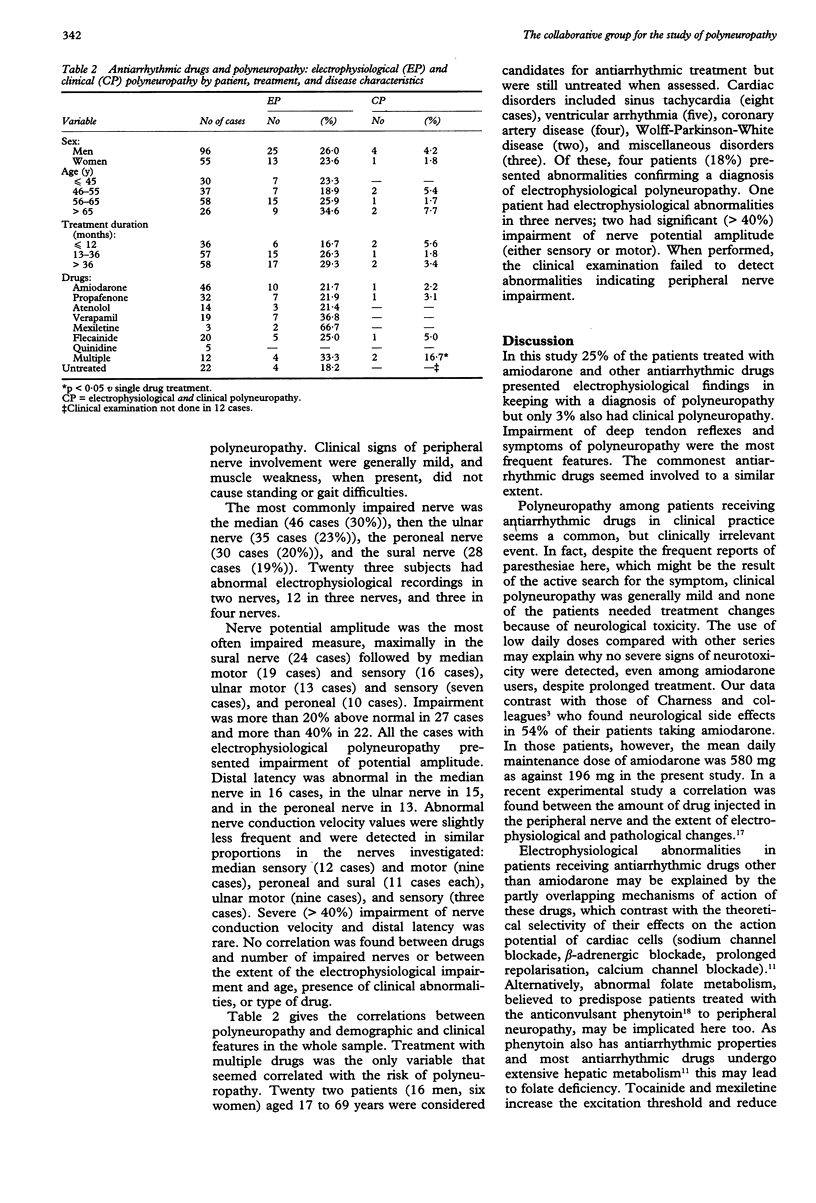Abstract
A total of 151 patients on chronic treatment with amiodarone and other antiarrhythmic drugs were subjected to standard clinical and electrophysiological investigation to assess the prevalence and specificity of polyneuropathy. Twenty two untreated patients with cardiac disorders and 246 normal subjects served as controls. Abnormal electrophysiological findings supporting the diagnosis of polyneuropathy were present in 38 subjects (25%) given antiarrhythmic drugs, with even distribution among drugs, and four untreated patients (18%). Concurrent clinical abnormalities were present in five treated patients (one each with amiodarone, propafenone, and flecainide, and two with multiple drugs). Therefore, electrophysiological abnormalities are a common, although non-specific, feature in patients taking antiarrhythmic drugs. Amiodarone users do not seem at higher risk of polyneuropathy than subjects treated with other drugs or even untreated patients with cardiac disorders.
Full text
PDF



Selected References
These references are in PubMed. This may not be the complete list of references from this article.
- Beghi E., Delodovici M. L., Bogliun G., Crespi V., Paleari F., Gamba P., Capra M., Zarrelli M. Hypothyroidism and polyneuropathy. J Neurol Neurosurg Psychiatry. 1989 Dec;52(12):1420–1423. doi: 10.1136/jnnp.52.12.1420. [DOI] [PMC free article] [PubMed] [Google Scholar]
- Charness M. E., Morady F., Scheinman M. M. Frequent neurologic toxicity associated with amiodarone therapy. Neurology. 1984 May;34(5):669–671. doi: 10.1212/wnl.34.5.669. [DOI] [PubMed] [Google Scholar]
- Costa-Jussà F. R., Jacobs J. M. The pathology of amiodarone neurotoxicity. I. Experimental studies with reference to changes in other tissues. Brain. 1985 Sep;108(Pt 3):735–752. doi: 10.1093/brain/108.3.735. [DOI] [PubMed] [Google Scholar]
- Dudognon P., Hauw J. J., de Baecque C., Derrida J. P., Escourolle R., Nick E. J. Neuropathie au chlorhydrate d'amiodarone. Etude clinique et histopathologique d'une nouvelle lipidose médicamenteuse. Rev Neurol (Paris) 1979 Jul-Aug;135(6-7):527–540. [PubMed] [Google Scholar]
- Fraser A. G., McQueen I. N., Watt A. H., Stephens M. R. Peripheral neuropathy during longterm high-dose amiodarone therapy. J Neurol Neurosurg Psychiatry. 1985 Jun;48(6):576–578. doi: 10.1136/jnnp.48.6.576. [DOI] [PMC free article] [PubMed] [Google Scholar]
- Hauw J. J., Mussini J. M., Boutry J. M., Escourolle R., Pollet S., Albouz S., Harpin M. L., Baumann N. Perhexiline maleate induced lipidosis in human peripheral nerve and tissue culture: ultrastructural and biochemical changes. Clin Toxicol. 1981 Dec;18(12):1405–1409. doi: 10.3109/15563658108990349. [DOI] [PubMed] [Google Scholar]
- Heger J. J., Prystowsky E. N., Jackman W. M., Naccarelli G. V., Warfel K. A., Rinkenberger R. L., Zipes D. P. Clinical efficacy and electrophysiology during long-term therapy for recurrent ventricular tachycardia or ventricular fibrillation. N Engl J Med. 1981 Sep 3;305(10):539–545. doi: 10.1056/NEJM198109033051002. [DOI] [PubMed] [Google Scholar]
- Horwitz S. J., Klipstein F. A., Lovelace R. E. Relation of abnormal folate metabolism to neuropathy developing during anticonvulsant drug therapy. Lancet. 1968 Mar 16;1(7542):563–565. doi: 10.1016/s0140-6736(68)92832-8. [DOI] [PubMed] [Google Scholar]
- Jacobs J. M., Costa-Jussà F. R. The pathology of amiodarone neurotoxicity. II. Peripheral neuropathy in man. Brain. 1985 Sep;108(Pt 3):753–769. doi: 10.1093/brain/108.3.753. [DOI] [PubMed] [Google Scholar]
- Kaeser H. E., Ulrich J., Wüthrich R. Amiodaron-Neuropathie. Schweiz Rundsch Med Prax. 1976 Sep 14;65(37):1121–1122. [PubMed] [Google Scholar]
- Keefe D. L., Kates R. E., Harrison D. C. New antiarrhythmic drugs: their place in therapy. Drugs. 1981 Nov;22(5):363–400. doi: 10.2165/00003495-198122050-00002. [DOI] [PubMed] [Google Scholar]
- Lemaire J. F., Autret A., Biziere K., Romet-Lemone J. L., Gray F. Amiodaron neuropathy: further arguments for human drug-induced neurolipidosis. Eur Neurol. 1982 Jan-Feb;21(1):65–68. doi: 10.1159/000115456. [DOI] [PubMed] [Google Scholar]
- Martinez-Arizala A., Sobol S. M., McCarty G. E., Nichols B. R., Rakita L. Amiodarone neuropathy. Neurology. 1983 May;33(5):643–645. doi: 10.1212/wnl.33.5.643. [DOI] [PubMed] [Google Scholar]
- Mason J. W. Amiodarone. N Engl J Med. 1987 Feb 19;316(8):455–466. doi: 10.1056/NEJM198702193160807. [DOI] [PubMed] [Google Scholar]
- Meier C., Kauer B., Müller U., Ludin H. P. Neuromyopathy during chronic amiodarone treatment. A case report. J Neurol. 1979 Jan 5;220(4):231–239. doi: 10.1007/BF00314147. [DOI] [PubMed] [Google Scholar]
- Pellissier J. F., Pouget J., Cros D., De Victor B., Serratrice G., Toga M. Peripheral neuropathy induced by amiodarone chlorhydrate. A clinicopathological study. J Neurol Sci. 1984 Feb;63(2):251–266. doi: 10.1016/0022-510x(84)90200-4. [DOI] [PubMed] [Google Scholar]
- Raeder E. A., Podrid P. J., Lown B. Side effects and complications of amiodarone therapy. Am Heart J. 1985 May;109(5 Pt 1):975–983. doi: 10.1016/0002-8703(85)90238-8. [DOI] [PubMed] [Google Scholar]
- Santoro L., Barbieri F., Nucciotti R., Battaglia F., Crispi F., Ragno M., Greco P., Caruso G. Amiodarone-induced experimental acute neuropathy in rats. Muscle Nerve. 1992 Jul;15(7):788–795. doi: 10.1002/mus.880150707. [DOI] [PubMed] [Google Scholar]
- Schwartz J. B., Keefe D., Harrison D. C. Adverse effects of antiarrhythmic drugs. Drugs. 1981 Jan;21(1):23–45. doi: 10.2165/00003495-198121010-00002. [DOI] [PubMed] [Google Scholar]
- Shah R. R., Oates N. S., Idle J. R., Smith R. L., Lockhart J. D. Prediction of subclinical perhexiline neuropathy in a patient with inborn error of debrisoquine hydroxylation. Am Heart J. 1983 Jan;105(1):159–161. doi: 10.1016/0002-8703(83)90297-1. [DOI] [PubMed] [Google Scholar]
- Talbot R. G., Julian D. G., Prescott L. F. Long-term treatment of ventricular arrhythmias with oral mexiletine. Am Heart J. 1976 Jan;91(1):58–65. doi: 10.1016/s0002-8703(76)80435-8. [DOI] [PubMed] [Google Scholar]
- Tippe A., Linderer E. M. Action of tocainide and mexiletine on the excitation threshold of myelinated nerves. Eur J Pharmacol. 1987 Sep 11;141(2):225–233. doi: 10.1016/0014-2999(87)90267-6. [DOI] [PubMed] [Google Scholar]
- Vaughan Williams E. M. A classification of antiarrhythmic actions reassessed after a decade of new drugs. J Clin Pharmacol. 1984 Apr;24(4):129–147. doi: 10.1002/j.1552-4604.1984.tb01822.x. [DOI] [PubMed] [Google Scholar]


